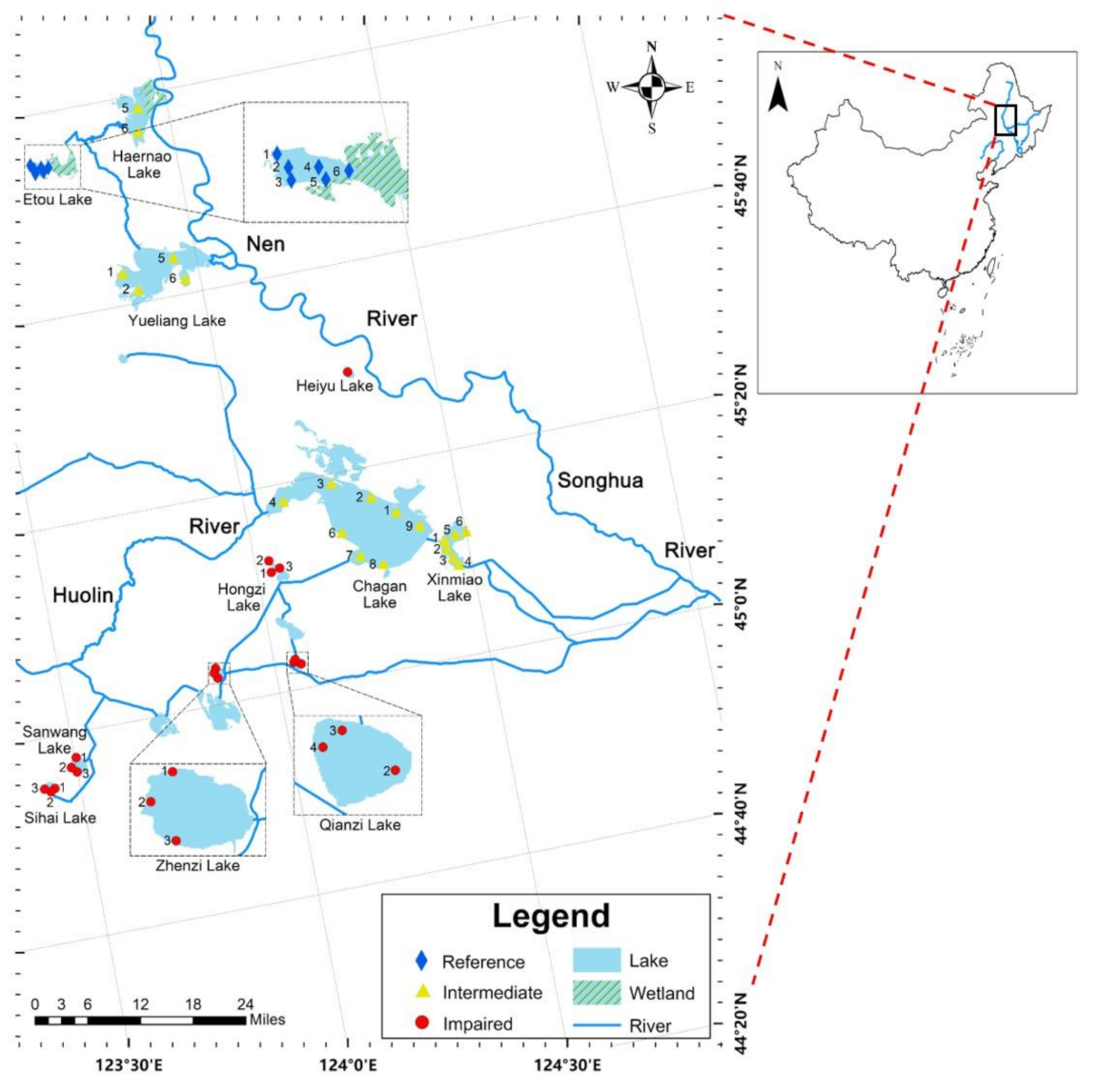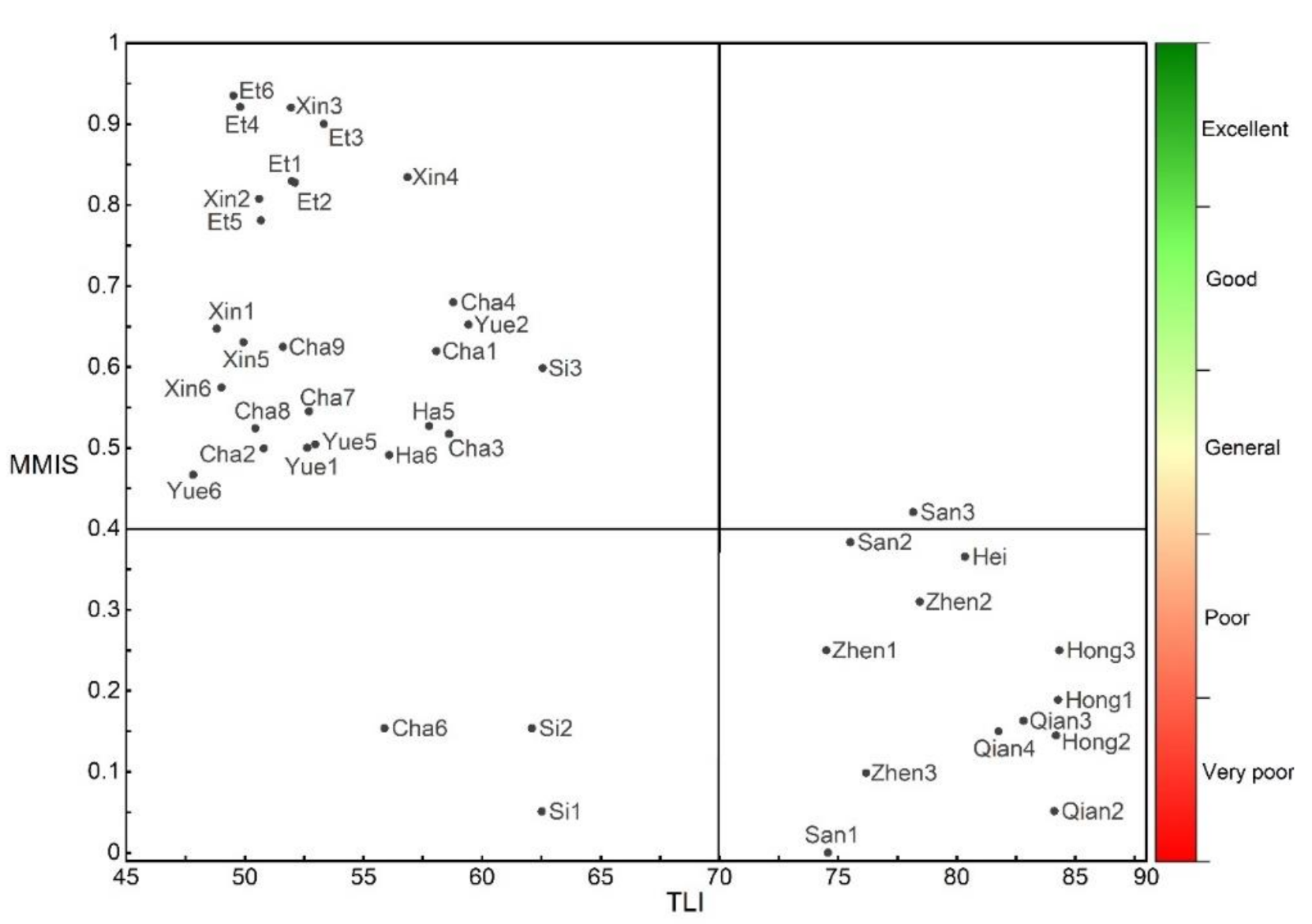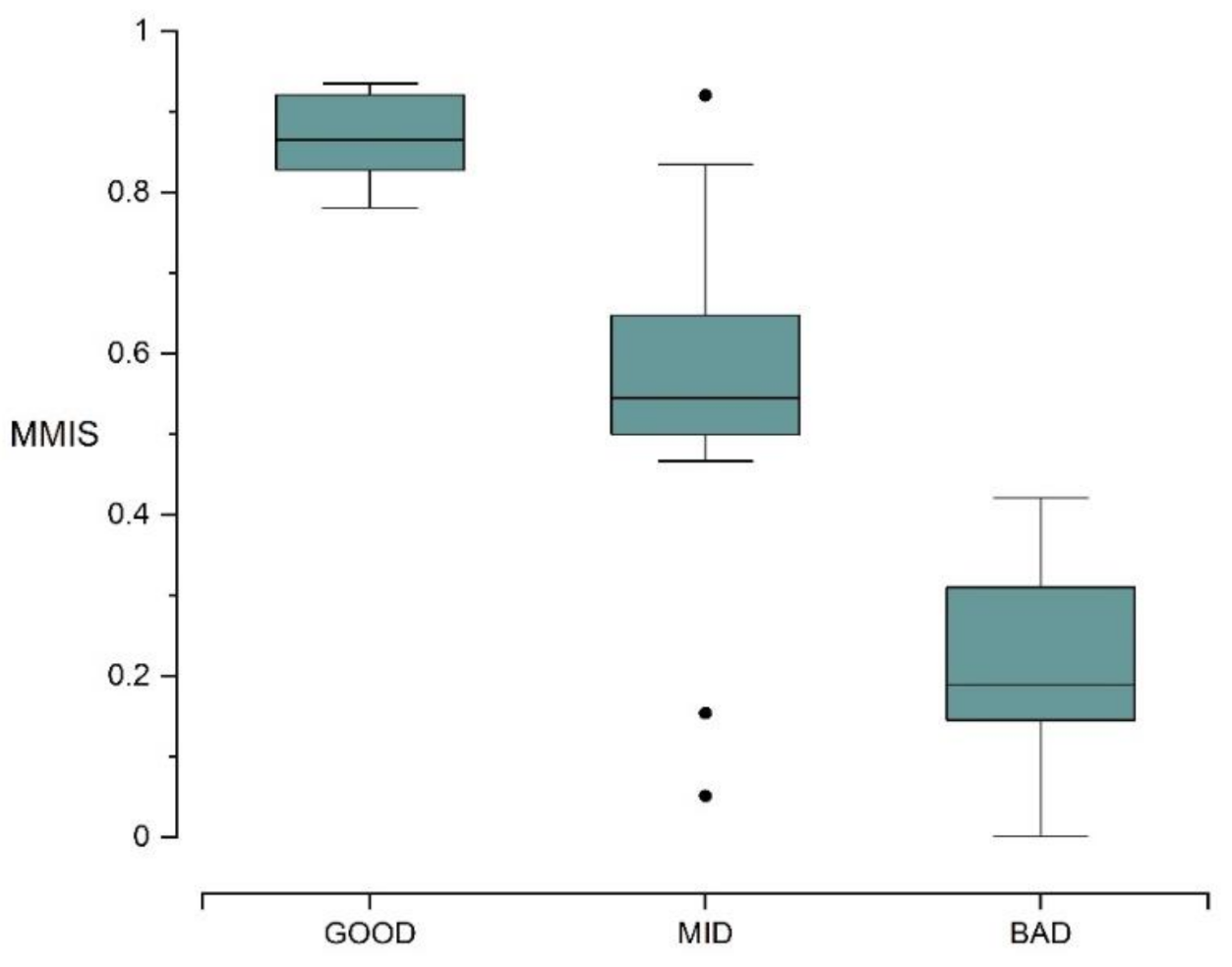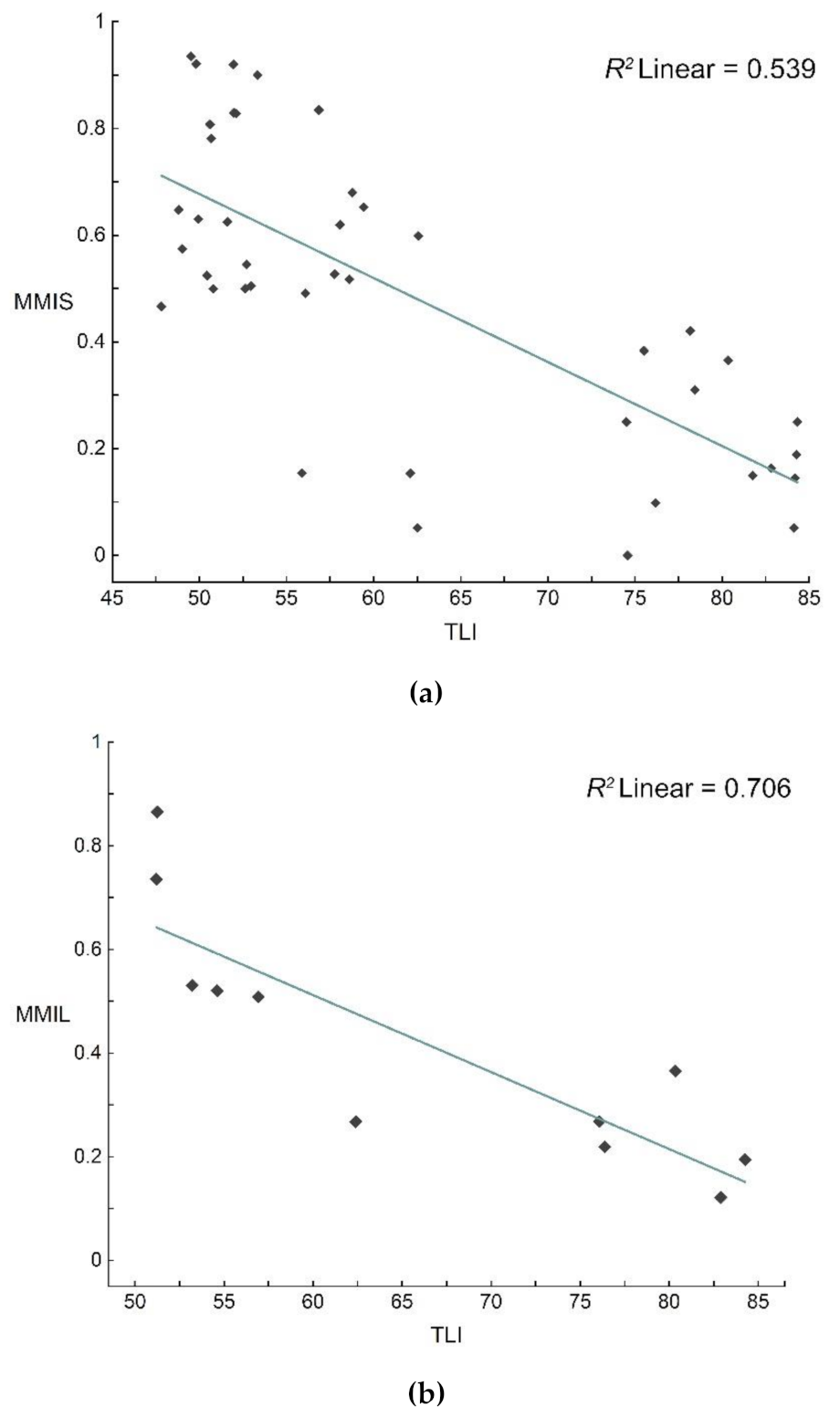An Assessment of Lake Ecology on the Basis of the Macrobenthos Multi-Metric Index (MMI) in 11 Lakes in the Western Region of Jilin, China
Abstract
:1. Introduction
2. Material and Methods
2.1. Sampling and Sites
2.2. Site Classification
- Impaired lakes: lakes with hyper-eutrophic conditions (TLI > 70).
- Reference lakes: since lakes in this region are generally disturbed by human activities, it is difficult to find truly undisturbed lakes. Therefore, the lake with the lowest TLI index and the same number of research sites as impaired lakes was selected as the reference lake. It represents the lake with the least human disturbance in this region.
- Intermediately impaired lakes: between the above two terms, these lakes are moderately affected by human disturbance.
2.3. Candidate Indicators
2.4. Screening of Candidate Indicators
- If there was no overlap in the interquartile range, IQ = 3.
- When there was a partial overlap but the median was outside others’ interquartile range, IQ = 2.
- When there was only one median within others’ quartile range, IQ = 1.
- When all medians were within the others’ quartile range, IQ = 0.
2.5. MMI Calculation
2.6. Testing and Analysis of MMI
3. Results
3.1. Selection of Metric and Calculation of MMI Results
3.2. Correlation Between MMI and Environmental Indicators
4. Discussion
4.1. Inspection of MMI
4.2. Indicator Selection and MMI Application
4.3. MMI Assessment Results
4.4. The Relationship Between MMI Index and Land Use Types Around the Lakes
5. Conclusions
Author Contributions
Funding
Institutional Review Board Statement
Informed Consent Statement
Data Availability Statement
Acknowledgments
Conflicts of Interest
Appendix A
| Metric Type | Candidate Metrics | Normal Distribution | Significant Difference | IQ | More than 1/3 Data were 0 |
| Taxonomic richness | The total number of taxa | Non-normal | YES | 3 | NO |
| The number of pollution-intolerant species taxa | Non-normal | YES | 3 | NO | |
| The number of pollution-tolerant species taxa | Non-normal | YES | 3 | NO | |
| The number of Arthropoda taxa | Non-normal | YES | 1 | - | |
| The number of Mollusca taxa | Normal | YES | 3 | NO | |
| The number of Annelida taxa | Non-normal | NO | - | - | |
| The number of Basommatophora taxa | Non-normal | YES | 3 | NO | |
| The number of Haplotaxida taxa | Non-normal | NO | - | - | |
| The number of Diptera taxa | Non-normal | YES | 2 | YES | |
| The number of Heterostropha taxa | Non-normal | NO | - | - | |
| The number of Mesogastropoda taxa | Non-normal | NO | - | - | |
| The number of Planorbidae taxa | Non-normal | YES | 3 | NO | |
| The number of Lymnaeidae taxa | Non-normal | YES | 3 | YES | |
| The number of Chironomidae taxa | Non-normal | YES | 3 | YES | |
| Community structure composition | % of Chironomidae | Non-normal | YES | 3 | YES |
| % of Lymnaeidae | Non-normal | YES | 3 | YES | |
| % of Planorbidae | Non-normal | NO | - | - | |
| % of Planorbidae + Tubificidae | Non-normal | NO | - | - | |
| % of Planorbidae + Lymnaeidae | Non-normal | NO | - | - | |
| % of Planorbidae + Chironomidae | Non-normal | NO | - | - | |
| % of Planorbidae + Valvatatiea | Non-normal | NO | - | - | |
| % of Haplotaxida | Non-normal | NO | - | - | |
| % of Basommatophora | Non-normal | NO | - | - | |
| % of Diptera | Non-normal | YES | 3 | YES | |
| % of Heterostropha | Non-normal | NO | - | - | |
| % of Mesogastropoda | Non-normal | NO | - | - | |
| % of Basommatophora + Haplotaxida | Non-normal | NO | - | - | |
| % of Basommatophora + Diptera | Non-normal | NO | - | - | |
| % of Basommatophora + Mesogastropoda | Non-normal | NO | - | - | |
| % of Basommatophora + Heterostropha | Non-normal | NO | - | - | |
| % of Diptera + Mesogastropoda | Non-normal | YES | 3 | NO | |
| % of Diptera + Heterostropha | Non-normal | NO | - | - | |
| % of Gastropoda | Non-normal | NO | - | - | |
| % of Oligochaeta | Non-normal | NO | - | - | |
| % of Insecta | Non-normal | NO | - | - | |
| % of Gastropoda + Oligochaeta | Non-normal | NO | - | - | |
| % of Gastropoda + Insecta | Non-normal | NO | - | - | |
| % of Oligochaeta + Insecta | Non-normal | NO | - | - | |
| % of dominant species | Normal | YES | 3 | NO | |
| Biodiversity index | Simpson index | Normal | YES | 3 | NO |
| Shannon–Wiener index | Normal | YES | 3 | NO | |
| Pielou index | Normal | YES | 1 | - | |
| Margalef index | Normal | YES | 3 | NO | |
| Pollution tolerance indicators | % of pollution-intolerant species | Non-normal | YES | 3 | NO |
| Biological monitoring working party (BMWP) | Normal | YES | 3 | NO | |
| Average score per taxon (ASPT) | Normal | YES | 3 | NO | |
| Family biotic index (FBI) | Non-normal | NO | - | - | |
| Biotic index (BI) | Normal | YES | 3 | NO | |
| Feeding function groups | % of SC | Non-normal | NO | - | - |
| % of GC | Non-normal | YES | 3 | YES | |
| % of FC | Non-normal | NO | - | - | |
| % of PR | Non-normal | NO | - | - | |
| % of SC + GC | Non-normal | YES | 1 | - | |
| % of SC + FC | Non-normal | NO | - | - | |
| % of SC + PR | Non-normal | NO | - | - | |
| % of GC + FC | Non-normal | NO | - | - | |
| % of GC + PR | Non-normal | NO | - | - | |
| % of FC + PR | Non-normal | YES | 1 | - |
Appendix B
| Lake | Abbreviated Name | Normal Acreage (km2) | Depth (m) | TLI | Aquatic Plant | MMI |
| Etou Lake | Et | 15 | 2.1 | 51.2 | Abundant | 0.86 |
| Haernao Lake | Ha | 33 | 3 | 56.9 | None | 0.50 |
| Yueliang Lake | Yue | 150 | 2.4 | 53.2 | None | 0.53 |
| Heiyu Lake | Hei | 1.5 | 1.8 | 80.4 | None | 0.36 |
| Chagan Lake | Cha | 307 | 4 | 54.6 | None | 0.52 |
| Xinmiao Lake | Xin | 31 | 2.2 | 51.2 | Abundant | 0.73 |
| Hongzi Lake | Hong | 18 | 2.7 | 84.3 | None | 0.19 |
| Qianzi Lake | Qian | 2.4 | 2 | 82.9 | None | 0.11 |
| Zhenzi Lake | Zhen | 3.7 | 2.1 | 76.4 | None | 0.22 |
| Sihai Lake | Si | 9.5 | 2 | 62.4 | None | 0.26 |
| Sanwang Lake | San | 4 | 2.3 | 76.1 | None | 0.26 |
References
- Xie, H.L.; Wang, P.; Huang, H.S. Ecological Risk Assessment of Land Use Change in the Poyang Lake Eco-economic Zone, China. Int. J. Environ. Res. Public Health 2013, 10, 328–346. [Google Scholar] [CrossRef] [Green Version]
- Xu, F.L.; Zhao, Z.Y.; Zhan, W.; Zhao, S.S.; Dawson, R.W.; Tao, S. An ecosystem health index methodology (EHIM) for lake ecosystem health assessment. Ecol. Model. 2005, 188, 327–339. [Google Scholar] [CrossRef]
- Bai, F. Research on the Degrades Mechanism and the Repairing Theory and Technology for Lake Ecosystem. Ph.D. Thesis, Changan University, Xian, China, August 2004. [Google Scholar]
- Zhang, Y.; Yang, G.; Wan, R. Ecosystem Health Assessment Indictors for Lakes. Resour. Sci. 2014, 36, 1306–1315. [Google Scholar]
- Birk, S.; Bonne, W.; Borja, A.; Brucet, S.; Courrat, A.; Poikane, S.; Solimini, A.; van de Bund, W.V.; Zampoukas, N.; Hering, D. Three hundred ways to assess Europe’s surface waters: An almost complete overview of biological methods to implement the Water Framework Directive. Ecol. Indic. 2012, 18, 31–41. [Google Scholar] [CrossRef]
- HaRa, J.; Mamun, M.; An, K.G. Ecological River Health Assessments Using Chemical Parameter Model and the Index of Biological Integrity Model. Water 2019, 11, 22. [Google Scholar] [CrossRef] [Green Version]
- Huang, Q.; Gao, J.; Zhang, Y.; Yan, R.; Wang, Y.; Cai, Y. Aquatic ecological integrity assessment of four large lakes in the middle-to-lower reaches of the Yangtze River, China. Acta Ecol. Sin. 2016, 36, 118–126. [Google Scholar]
- Poikane, S.; Ritterbusch, D.; Argillier, C.; Bialokoz, W.; Blabolil, P.; Breine, J.; Jaarsma, N.G.; Krause, T.; Kubecka, J.; Lauridsen, T.L.; et al. Response of fish communities to multiple pressures: Development of a total anthropogenic pressure intensity index. Sci. Total Environ. 2017, 586, 502–511. [Google Scholar] [CrossRef] [PubMed]
- Chen, K.; Hughes, R.M.; Xu, S.; Zhang, J.; Cai, D.; Wang, B. Evaluating performance of macroinvertebrate-based adjusted and unadjusted multi-metric indices (MMI) using multi-season and multi-year samples. Ecol. Indic. 2014, 36, 142–151. [Google Scholar] [CrossRef]
- Klemm, D.J.; Blocksom, K.A.; Fulk, F.A.; Herlihy, A.T.; Hughes, R.M.; Kaufmann, P.R.; Peck, D.V.; Stoddard, J.L.; Thoeny, W.T.; Griffith, M.B.; et al. Development and evaluation of a Macroinvertebrate Biotic Integrity Index (MBII) for regionally assessing Mid-Atlantic Highlands streams. Environ. Manag. 2003, 31, 656–669. [Google Scholar] [CrossRef] [PubMed]
- Lakew, A.; Moog, O. A multimetric index based on benthic macroinvertebrates for assessing the ecological status of streams and rivers in central and southeast highlands of Ethiopia. Hydrobiologia 2015, 751, 229–242. [Google Scholar] [CrossRef]
- Mondy, C.P.; Villeneuve, B.; Archaimbault, V.; Usseglio-Polatera, P. A new macroinvertebrate-based multimetric index (I2M2) to evaluate ecological quality of French wadeable streams fulfilling the WFD demands: A taxonomical and trait approach. Ecol. Indic. 2012, 18, 452–467. [Google Scholar] [CrossRef]
- Silva, D.R.O.; Herlihy, A.T.; Hughes, R.M.; Callisto, M. An improved macroinvertebrate multimetric index for the assessment of wadeable streams in the neotropical savanna. Ecol. Indic. 2017, 81, 514–525. [Google Scholar] [CrossRef]
- Schoolmaster, D.R.; Grace, J.B.; Schweiger, E.W. A general theory of multimetric indices and their properties. Methods Ecol. Evol. 2012, 3, 773–781. [Google Scholar] [CrossRef]
- Karr, J.R. Assessment of Biotic Integrity Using Fish Communities. Fisheries 1981, 6, 21–27. [Google Scholar] [CrossRef]
- Fierro, P.; Arismendi, I.; Hughes, R.M.; Valdovinos, C.; Jara-Flores, A. A benthic macroinvertebrate multimetric index for Chilean Mediterranean streams. Ecol. Indic. 2018, 91, 13–23. [Google Scholar] [CrossRef]
- Larras, F.; Coulaud, R.; Gautreau, E.; Billoir, E.; Rosebery, J.; Usseglio-Polatera, P. Assessing anthropogenic pressures on streams: A random forest approach based on benthic diatom communities. Sci Total Environ. 2017, 586, 1101–1112. [Google Scholar] [CrossRef]
- Bolding, M.T.; Kraft, A.J.; Robinson, D.T.; Rooney, R.C. Improvements in multi-metric index development using a whole-index approach. Ecol. Indic. 2020, 113. [Google Scholar] [CrossRef]
- Hering, D.; Feld, C.K.; Moog, O.; Ofenböck, T. Cook book for the development of a Multimetric Index for biological condition of aquatic ecosystems: Experiences from the European AQEM and STAR projects and related initiatives. Hydrobiologia 2006, 566, 311–324. [Google Scholar] [CrossRef]
- Hughes, R.M.; Kaufmann, P.R.; Herlihy, A.T.; Kincaid, T.M.; Reynolds, L.; Larsen, D.P. A process for developing and evaluating indices of fish assemblage integrity. Can. J. Fish. Aquat. Sci. 1998, 55, 1618–1631. [Google Scholar] [CrossRef]
- Karr, J.R.; Dudley, D.R. Ecological perspective on water quality goals. Environ. Manag. 1981, 5, 55–68. [Google Scholar] [CrossRef]
- Cai, K.; Zhang, J.; Xu, Z.a.; Wu, D.; Zhang, Y.; Wang, B. Application of a benthic index of biotic integrity for the ecosystem health assessment of Lake Taihu. J. Lake Sci. 2014, 26, 74–82. [Google Scholar]
- Huang, Q.; Gao, J.; Cai, Y.; Yin, H.; Gao, Y.; Zhao, J.; Liu, L.; Huang, J. Development and application of benthic macroinvertebrate-based multimetric indices for the assessment of streams and rivers in the Taihu Basin, China. Ecol. Indic. 2015, 48, 649–659. [Google Scholar] [CrossRef]
- Taowu, M.; Qinghui, H.; Hai, W.; Zijian, W.; Chunxia, W.; Shengbiao, H. Selection of benthic macroinvertebrate-based multimetrics and preliminary establishment of biocriteria for the bioassessment of the water quality of Taihu Lake, China. Acta Ecol. Sin. 2008, 28, 1192–1200. [Google Scholar] [CrossRef]
- Zhang, Y.; Cheng, L.; Kong, M.; Li, W.; Gong, Z.; Zhang, L.; Wang, X.; Cai, Y.; Li, K. Utility of a macroinvertebrate-based multimetric index in subtropical shallow lakes. Ecol. Indic. 2019, 106. [Google Scholar] [CrossRef]
- Jingting, G. Dynamic Changes and Driving Forces of Lake Resources in Jilin Province in Recent 20 Years. Master’s Thesis, Jilin University, Changchun, China, June 2018. [Google Scholar]
- Leng, L.; Zhang, H.; Zhang, M.; Li, T.; Liu, X.; Qu, X. Application of The Biological Monitoring Working Party (BMWP) Score System of Macroinvertebrates for River Health In Taizi River Basin. Resour. Environ. Yangtze Basin 2016, 25, 1781–1788. [Google Scholar]
- Li, R.; Zhang, G.; Wei, X.; Liu, Y.; Zhang, L.; Sun, S. The Evolutional Characteristics ofWater Environment of Chagan LakeWetland. Sci. Geogr. Sin. 2014, 34, 762–768. [Google Scholar] [CrossRef]
- Serrano Balderas, E.C.; Grac, C.; Berti-Equille, L.; Armienta Hernandez, M.A. Potential application of macroinvertebrates indices in bioassessment of Mexican streams. Ecol. Indic. 2016, 61, 558–567. [Google Scholar] [CrossRef]
- Honglei, L. Water Resource Management and Protection in Momogee Wetland. Master’s Thesis, Jilin University, Changchun, China, June 2019. [Google Scholar]
- Long, Z.; Sun, S.; Ou, Y.; Cui, P.; Ran, X. Characteristics of Quality ofWater Enviroment and Macrobenthos Community in the 10 Shallow Lakes inWestern Jilin Province. Wetland Sci. 2018, 16, 642–650. [Google Scholar]
- Zhai, D.; Sun, S.; Feng, J.; Long, Z.; Ou, Y.; Cui, P. Distribution Characteristics of Macrobenthos in Chagan Lake and Their Influencing Factors. J. Jilin Agric. Univ. 2019, 41, 365–372. [Google Scholar]
- Chen, L.W.; Zhang, G.X.; Xu, Y.J.; Chen, S.B.; Wu, Y.F.; Gao, Z.T.; Yu, H.Y. Human Activities and Climate Variability Affecting Inland Water Surface Area in a High Latitude River Basin. Water 2020, 12, 17. [Google Scholar] [CrossRef] [Green Version]
- Wang, H.; Zhang, M.; Cui, L.; Sheng, L.; He, C.; Xiao, Y.; Yang, S. Ecosystem Health Assessment of Momoge Wetland in Jilin. Wetland Sci. Manag. 2016, 12, 17–22. [Google Scholar]
- Demin, L. Freshwater Biology, 1st ed.; Soochow University Press: Suzhou, China, 2000. [Google Scholar]
- Weiguang, Q. Monitoring Map of Benthic Fauna in Liaohe River Basin, 1st ed.; China Environment Publishing Group: Beijing, China, 2014. [Google Scholar]
- China, E.P.A. Methods for Monitoring and Analysis of Water and Wastewater, 4th ed.; China Environment Publishing Group: Beijing, China, 2002. [Google Scholar]
- Hughes, R.M.; Larsen, D.P.; Omernik, J.M.J.E.M. Regional reference sites: A method for assessing stream potentials. Environ. Manag. 1986, 10, 629–635. [Google Scholar] [CrossRef]
- Wang, M. Evaluate method and classification standard on lake eutrophication. Environ. Monit. China 2002, 18, 47–49. [Google Scholar]
- Lu, K.L.; Wu, H.T.; Xue, Z.S.; Lu, X.G.; Batzer, D.P. Development of a multi-metric index based on aquatic invertebrates to assess floodplain wetland condition. Hydrobiologia 2019, 827, 141–153. [Google Scholar] [CrossRef]
- Hering, D.; Moog, O.; Sandin, L.; Verdonschot, P.F.M. Overview and application of the AQEM assessment system. Hydrobiologia 2004, 516, 1–20. [Google Scholar] [CrossRef]
- Wang, Y.; Li, L.; Lin, K.; Zhu, Y.; Xia, Y.; Liu, L. Development and Applicability Analysis of Benthic-Macroinvertebrate Index of Biotic Integrity in the Songhua River Basin. Environ. Monit. China 2019, 35, 20–30. [Google Scholar]
- Kong, F.; Yu, R.; Xu, Z.; Zhou, M. Application of excel in calculation of biodiversity indices. Marine Sci. 2012, 36, 57–62. [Google Scholar]
- Zhang, J.; Cai, K.; Yu, H.; Jiang, Y.; Li, X.; Zhou, S.; Xie, Z.; Wang, Y.; Jin, X.; Wang, B. Establishment of Chinese Macroinvertebrate Score Index and Water Quality Boundary. Environ. Monit. China 2018, 34, 10–18. [Google Scholar] [CrossRef]
- Zeybek, M.; Kalyoncu, H.; Karakas, B.; Ozgul, S. The use of BMWP and ASPT indices for evaluation of water quality according to macroinvertebrates in Degirmendere Stream (Isparta, Turkey). Turk. J. Zool. 2014, 38, 603–613. [Google Scholar] [CrossRef]
- Geng, S.-W.; Qu, X.-D.; Zhang, Y.; Lin, K.-D. Comparison and application of biological indices of macroinvertebrates in river health assessment. Huan jing ke xue Huanjing kexue 2012, 33, 2281–2287. [Google Scholar]
- Zhang, Y.; Ding, S.; Zhang, Y.; Gao, X.; Wang, S.; Lin, J. Effects of Land Use on Macroinvertebrate Functional Feeding Groups in Taizi River Basin. Res. Environ. Sci. 2018, 31, 1527–1536. [Google Scholar]
- Wang, B.; Wu, D.; Zhang, J.; Yin, X.; Zhao, C.; Dou, T. Diversity and temporal-spatial dynamics of macroinvertebrate functional feeding groups in the rivers of the Jinan Region. Acta Ecol. Sin. 2017, 37, 7128–7139. [Google Scholar]
- Barbour, M.T.; Gerritsen, J.; Snyder, B.D.; Stribling, J.B. Rapid Bioassessment Protocols Foruse in Streams and Wadable Rivers: Periphyton, Benthic Invertebrates and Fish; US Environmental Protection Agency, Office of Water: Washington, DC, USA, 1999.
- Mereta, S.T.; Boets, P.; De Meester, L.; Goethals, P.L.M. Development of a multimetric index based on benthic macroinvertebrates for the assessment of natural wetlands in Southwest Ethiopia. Ecol. Indic. 2013, 29, 510–521. [Google Scholar] [CrossRef]
- Stoddard, J.L.; Herlihy, A.T.; Peck, D.V.; Hughes, R.M.; Whittier, T.R.; Tarquinio, E. A process for creating multimetric indices for large-scale aquatic surveys. J. N. Am. Benthol. Soc. 2008, 27, 878–891. [Google Scholar] [CrossRef]
- Jun, Y.C.; Won, D.H.; Lee, S.H.; Kong, D.S.; Hwang, S.J. A multimetric benthic macroinvertebrate index for the assessment of stream biotic integrity in Korea. Int J. Environ. Res. Public Health 2012, 9, 3599–3628. [Google Scholar] [CrossRef]
- Oliveira, R.B.S.; Baptista, D.F.; Mugnai, R.; Castro, C.M.; Hughes, R.M. Towards rapid bioassessment of wadeable streams in Brazil: Development of the Guapiacu-Macau Multimetric Index (GMMI) based on benthic. Ecol. Indic. 2011, 11, 1584–1593. [Google Scholar] [CrossRef]
- Fengxia, Z.; Jianhong, C. Freshwater Microbiome and Benthic Fauna Map, 2nd ed.; Chemical Industry Press: Beijing, China, 2011. [Google Scholar]
- Tianyi, Z.; Xindong, W.; Jianwei, D. Analysis on Water Quality Changes in Chagan Lake. China Resour. Compr. Utiliz. 2015, 33, 56–61. [Google Scholar]
- Odountan, O.H.; de Bisthoven, L.J.; Abou, Y.; Eggermont, H. Biomonitoring of lakes using macroinvertebrates: Recommended indices and metrics for use in West Africa and developing countries. Hydrobiologia 2019, 826, 1–23. [Google Scholar] [CrossRef]
- Miler, O.; Porst, G.; McGoff, E.; Pilotto, F.; Donohue, L.; Jurca, T.; Solimini, A.; Sandin, L.; Irvine, K.; Aroviita, J.; et al. Morphological alterations of lake shores in Europe: A multimetric ecological assessment approach using benthic macroinvertebrates. Ecol. Indic. 2013, 34, 398–410. [Google Scholar] [CrossRef]
- Bellucci, C.J.; Becker, M.E.; Beauchene, M.; Dunbar, L.J.E.M. Classifying the Health of Connecticut Streams Using Benthic Macroinvertebrates with Implications for Water Management. Environ. Manag. 2013, 51, 1274–1283. [Google Scholar] [CrossRef]
- Kangle, L.U.; Haitao, W.U.; Xianguo, L.U.; Qiang, G.; Zhanyan, C.J.W.E. Health Assessment of Marsh Wetlands in the Sanjiang Plain Using Index of Biotic Integrity of Aquatic Invertebrates. Wetl. Sci. 2017, 15, 670–679. [Google Scholar]
- Shull, D.R.; Smith, Z.M.; Selckmann, G.M. Development of a benthic macroinvertebrate multimetric index for large semiwadeable rivers in the Mid-Atlantic region of the USA. Environ. Monit. Assess. 2019, 191, 19. [Google Scholar] [CrossRef] [PubMed]
- Wang, C.; Zhang, Y.; Shi, H.; Li, L.; Huang, D.; Tian, Q.; Chen, X.; Gong, Z.; Li, H. Macrozoobenthic community structure and bioassessment of water quality in Lake Dongting, China. J. Lake Sci. 2016, 28, 395–404. [Google Scholar]
- Frouin, P. Effects of anthropogenic disturbances of tropical soft-bottom benthic communities. Mar. Ecol. Prog. Ser. 2000, 194, 39–53. [Google Scholar] [CrossRef]
- Rodriguez-Gallego, L.; Meerhoff, E.; Clemente, J.M.; Conde, D. Can ephemeral proliferations of submerged macrophytes influence zoobenthos and water quality in coastal lagoons? Hydrobiologia 2010, 646, 253–269. [Google Scholar] [CrossRef]





| 0–0.2 | 0.2–0.4 | 0.4–0.6 | 0.6–0.8 | 0.8–1.0 |
|---|---|---|---|---|
| Very poor | Poor | General | Good | Excellent |
Publisher’s Note: MDPI stays neutral with regard to jurisdictional claims in published maps and institutional affiliations. |
© 2021 by the author. Licensee MDPI, Basel, Switzerland. This article is an open access article distributed under the terms and conditions of the Creative Commons Attribution (CC BY) license (http://creativecommons.org/licenses/by/4.0/).
Share and Cite
Ding, Y.-f.; Sun, S.-j.; Feng, J.; Cui, P.; Zhang, D.; Long, Z.-y. An Assessment of Lake Ecology on the Basis of the Macrobenthos Multi-Metric Index (MMI) in 11 Lakes in the Western Region of Jilin, China. Water 2021, 13, 235. https://doi.org/10.3390/w13020235
Ding Y-f, Sun S-j, Feng J, Cui P, Zhang D, Long Z-y. An Assessment of Lake Ecology on the Basis of the Macrobenthos Multi-Metric Index (MMI) in 11 Lakes in the Western Region of Jilin, China. Water. 2021; 13(2):235. https://doi.org/10.3390/w13020235
Chicago/Turabian StyleDing, Yi-fan, Shi-jun Sun, Jiang Feng, Peng Cui, Dan Zhang, and Zhen-yu Long. 2021. "An Assessment of Lake Ecology on the Basis of the Macrobenthos Multi-Metric Index (MMI) in 11 Lakes in the Western Region of Jilin, China" Water 13, no. 2: 235. https://doi.org/10.3390/w13020235
APA StyleDing, Y.-f., Sun, S.-j., Feng, J., Cui, P., Zhang, D., & Long, Z.-y. (2021). An Assessment of Lake Ecology on the Basis of the Macrobenthos Multi-Metric Index (MMI) in 11 Lakes in the Western Region of Jilin, China. Water, 13(2), 235. https://doi.org/10.3390/w13020235






